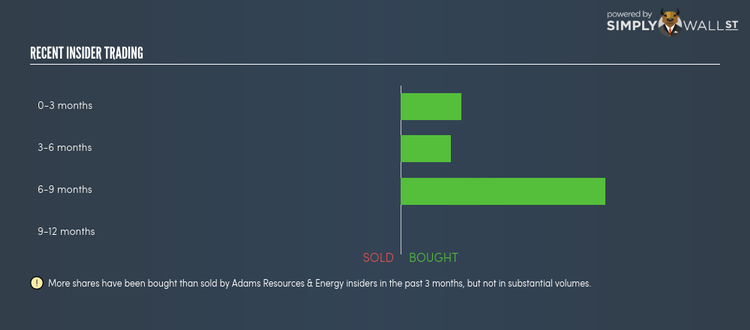What You Must Know About Adams Resources & Energy Inc’s (NYSEMKT:AE) Major Investors

In this article, I will take a quick look at Adams Resources & Energy Inc’s (AMEX:AE) recent ownership structure – an unconventional investing subject, but an important one. Ownership structure has been found to have an impact on shareholder returns in both short- and long-term. Since the effect of an active institutional investor with a similar ownership as a passive pension-fund can be vastly different on a company’s corporate governance and accountability of shareholders, investors should take a closer look at AE’s shareholder registry. All data provided is as of the most recent financial year end.
See our latest analysis for Adams Resources & Energy
Institutional Ownership
AE’s 33.14% institutional ownership seems enough to cause large share price movements in the case of significant share sell-off or acquisitions by institutions, particularly when there is a low level of public shares available on the market to trade. Although AE has a high institutional ownership, such stock moves, in the short-term, are more commonly linked to a particular type of active institutional investors – hedge funds. With hedge funds holding a 6.89% stake in the company, its share price can experience heightened volatility. But I also examine other ownership types and their potential impact on AE’s investment case.
Insider Ownership
I find insiders are another important group of stakeholders, who are directly involved in making key decisions related to the use of capital. In essence, insider ownership is more about the alignment of shareholders’ interests with the management. A major group of owners of AE is individual insiders, sitting with a hefty 10.19% stake in the company. Broadly, insider ownership of this level has been found to negatively affect companies with consistently low PE ratio (underperforming). And a positive impact has been seen on companies with a high PE ratio (outperforming). Another aspect of insider ownership is to learn about their recent transactions. Insiders buying company shares can be a positive indicator of future performance, but a selling decision can simply be driven by personal financial needs.
General Public Ownership
A big stake of 10.79% in AE is held by the general public. With this size of ownership, retail investors can collectively play a role in major company policies that affect shareholders returns, including executive remuneration and the appointment of directors. They can also exercise the power to decline an acquisition or merger that may not improve profitability.
Private Company Ownership
Another important group of owners for potential investors in AE are private companies that hold a stake of 38.99% in AE. These are companies that are mainly invested due to their strategic interests or are incentivized by reaping capital gains on investments their shareholdings. With this size of ownership in AE, this ownership class can affect the company’s business strategy. As a result, potential investors should further explore the company’s business relations with these companies and find out if they can affect shareholder returns in the long-term.
What this means for you:
I suggest investors seek some degree of margin of safety due to high institutional ownership in AE, in particular due to the strong presence of active hedge fund investors. This will allow an investor to reduce the impact of non-fundamental factors, such as volatile block trading impact on their portfolio value. However, ownership structure should not be the only determining factor when you’re building an investment thesis for AE. Rather, you should be examining fundamental factors such as the intrinsic valuation, which is a key driver of Adams Resources & Energy’s share price. I urge you to complete your research by taking a look at the following:
1. Financial Health: Is AE’s operations financially sustainable? Balance sheets can be hard to analyze, which is why we’ve done it for you. Check out our financial health checks here.
2. Past Track Record: Has AE been consistently performing well irrespective of the ups and downs in the market? Go into more detail in the past performance analysis and take a look at the free visual representations of AE’s historicals for more clarity.
3. Other High-Performing Stocks: Are there other stocks that provide better prospects with proven track records? Explore our free list of these great stocks here.
NB: Figures in this article are calculated using data from the last twelve months, which refer to the 12-month period ending on the last date of the month the financial statement is dated. This may not be consistent with full year annual report figures.
To help readers see pass the short term volatility of the financial market, we aim to bring you a long-term focused research analysis purely driven by fundamental data. Note that our analysis does not factor in the latest price sensitive company announcements.
The author is an independent contributor and at the time of publication had no position in the stocks mentioned.


